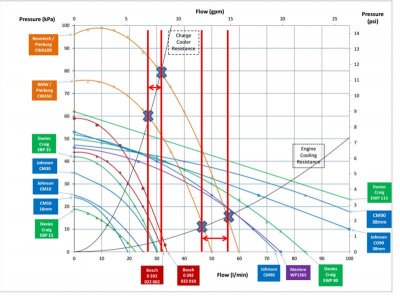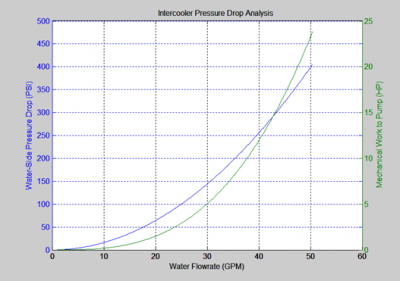Department Of Boost
Alpha Geek
- Joined
- May 26, 2010
- Posts
- 8,809
- Reaction score
- 28
I'm not getting into this with you.
Racer47, you are on the right track with your thinking. Just keep in mind the graphs you posted would be for relatively small liquid to air heat exchangers which is why they seem to assymptote at lower flow rates than what Squid is proclaiming. The necessity and benefit of flowrate is uniquely driven by the size of the heat exchangers in the loop.
Austin
Thanks for chiming in with some data. I know the flow numbers are not absolute. I was just looking for data. I know its a system thing like I said in post #64 of this thread
"So the added cost of going from the 50 to the 100 is probably not going to result in any meaningful IAT reduction for my KB and AFCO system. I bet the Mercedes systems are bigger and flow more water and see a real benefit from the CWA100's."
I think you're looking at that backward. You have the most restrictive IC out there. You can use a high pressure pump more than anyone.

No.
I don't know anything about the flow impedance characteristics of the KB IC or the Afco radiator. But, having a more restrictive intercooler probably means the overall size is smaller

I'm not following how X surface area (large, med, small, whatever) doesn't improve with more flow rate. Assuming that there already isn't enough flow rate to remove the entire heat load. I get diminishing returns, I don't get "not improve" though.It follows that smaller ICs are more restrictive and have less surface area and have larger "non-flowrate-impacted resistances" that do not improve with better flow.
What cost? What are you "spending"?They will see less benefit from increases in coolant flow rate and the pumping power loss per GPM increase will cost significantly more in efficiency loss than a less restrictive larger heat exchanger.
Keeping them cool enough to run the 1/4 (an actual drag strip) is not that big of a deal......for most cars. When you start playing with 10lb+ of boost it gets more difficult. When you get to 15lb of boost it gets hard. At 20lb of boost it's almost impossible to do without ice water, e85 or both. That's at the strip where you get to cool the car down between passes though. If you're driving around on the street, sitting at stoplights, etc the system will heat saturate and most of the time if you were to punch it you won't make it 1/4mi before it starts to pull timing. That is with the "as delivered" systems that come with the PD kits.Now the questions (since I'm N/A and just an observer). Do these PD blowers make so much heat so fast that this will always be a problem? Is it reasonable to think it is even possible to cool them down in a 1/4 mile?
The hotter the water in the HE the more efficient it is.The IC extracts the heat....the HE dumps it. IMO, any increase the flow rate in the loop is not going to buy you very much...unless the HE is a helluva lot bigger /and /or more air through the HE.
This is a game of "not very much". That means you have to take as many "not very much's" as you can, whenever you can. It's the same as the weight savings saying, "Ounces add up to pounds"."is not going to buy you very much"
The hotter the water in the HE the more efficient it is.
The hotter the water is the faster you want to move it through the IC.
Faster = good.
I NEVER said anything resembling that.Ok, so install a smaller HE, to get the coolant even hotter inside it..... to increase it's ...'efficiency'. Nobody is about to do that.
You mis-understood what I wrote and now you're being condescending? To the guy who has achieved the lowest IAT's of anyone......ever? Come on man. SMH.The blower discharge produces X BTU's. You have to get rid of it....or at least enough of it, to get the IAT's down to something reasonable. So you require an IC / pump / HE to dump X amount of BTU's. This isn't rocket science.
Already have.That 13/14 GT-500 HE + a 50/100 pump is probably going to be as good as it gets, unless you can come up with an even bigger HE..that will still fit.
But, having a more restrictive intercooler probably means the overall size is smaller
It's not.
Care to change that hard "no" to a maybe?

I'm not following how X surface area (large, med, small, whatever) doesn't improve with more flow rate. Assuming that there already isn't enough flow rate to remove the entire heat load. I get diminishing returns, I don't get "not improve" though.
Does increased flow rate reduce the overall thermal resistance? Absolutely, if R3 and R4 go down, the sum of R1 + R2 + R3 + R4 + R5 + R6 will also go down. Is there a point where reducing R3 and R4 no longer appreciably decreases the thermal resistance? Absolutely.
What cost? What are you "spending"?

You'll have to be more clear, then, on what you mean by "restrictive" as you noted racer47's to be the "most restrictive". Restrictive tends to imply the flow path has too few or too small of passages for fluid to pass through resulting in very high differential pressure across the device. I may have made a poor assumption you knew how to use the word 'restrictive' in the context of an IC?
Did you even read my first post?
From Nutter281:
What I 'also' said was that in the perfect analogy of two resistors in series, it literally doesn't matter if you increase flow rate to infinity, you can never take your total resistance lower than the sum of the other resistors in the series. A small heat exchanger will have very 'large' conductive and air-side resistances that won't change when the coolant flow rate is increased.
Pump power my dear boy. Doesn't matter if it is mechanical pulley or electrical via alternator going into your battery, energy to move the water is coming from 'somewhere'. See chart below - the pumping power is not negligible when you are chasing after that "not very much".
View attachment 55950
At some point, the horsepower you gain by decreased IATs will be less than the horsepower you spend to move the water faster - that is a fact. The heat exchanger in the attached graph was not 'particularly' restrictive - in fact, it is one that "you" might call the "least restrictive"
Also, keep in mind that the attached graph is for the IC only - flow rate is the same everywhere in the loop so increasing flow rate in the IC also means eating extra pump power through every other device, elbow, hose length, HE, etc.
I'm not sure if this is news or not, but Flowrate * Pressure Drop = Mechanical Work and Mechanical Work / Efficiency = Input Power (horse power). Unless you decouple your battery from the alternator and only power the pump from a large electrical capacitance, the pump power is coming out of your engine power.
Thanks,
Austin
So why all this like epic intercooler and pump hair splitting when you can just run a ~800$ killer chiller setup and have 60 degree water all the time lol
